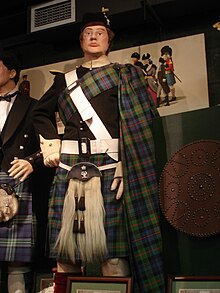Atholl Highlanders
The Atholl Highlanders are a private, ceremonial Scottish infantry regiment. Regiment owner ( Colonel-in-Chief ) is the respective Duke of Atholl . It is now a tourist attraction in Blair Castle , where it is stationed.
The regiment is not part of the British Army , but received a regimental flag from Queen Victoria in 1845 and is therefore officially recognized by the British Crown, making it the “only legal private army in Europe”.
history

The origins of the unit are in an infantry regiment , the 77th Regiment of Foot (Atholl Highlanders) . This had a nominal strength of 10,000 men and was set up on the occasion of the American War of Independence in December 1777 by John Murray, 4th Duke of Atholl from private funds for the British army . The regiment served to relieve other regiments that were posted to North America and served mainly as a garrison in Dublin . When the regiment was to be relocated to India in 1781 , a mutiny broke out , whereupon the members of the regiment were distributed to other regiments in June 1781 and the regiment was finally disbanded in April 1783. The regiment had not participated in any combat operations until then.
In 1839, George Murray, 2nd Baron Glenlyon , who later became the 6th Duke of Atholl, founded a private regiment as his ceremonial bodyguard , which he also called "Atholl Highlanders". This unit has nothing to do with the aforementioned military unit except for the name and the connection to the Dukes of Atholl. In 1842 and 1844, the unit provided the ceremonial bodyguard of Queen Victoria when she visited Scotland and stayed for a long time at the ancestral home of the Dukes of Atholl Blair Castle . In recognition of this service, at the request of the Queen, the Atholl Highlanders received a regimental standard on September 24, 1845 and thus official status.
The regiment performs purely ceremonial tasks, such as protocol honorary service , and was never designed to take part in combat operations. During the two world wars , the regiment's activity was idle, as many members of the regiment were drafted into the British military.
present
Today the Atholl Highlanders are a unit of about 125 men with purely ceremonial tasks. The unit includes two bagpipe bands in particular . Membership can only be acquired through a personal invitation from the duke.
The regiment wears the tartan of Clan Murray of Atholl. On festive occasions, a tuft of juniper is worn on the hat; the juniper is the plant badge of this clan .
The symbolic task of the unit is the defense of Blair Castle and its surroundings. The Highlanders perform annually at the Atholl Gathering Highland Games ; on this occasion they are inspected by the duke.
literature
- Atholl Highlanders, the. In: Ian Crofton: A Dictionary of Scottish Phrase and Fable. Birlinn, Edinburgh 2012, ISBN 0857906372 .
Web links
- Atholl Highlanders ( Memento from July 26, 2011 in the Internet Archive )
Individual evidence
- ↑ John Malcolm Bulloch: The 'mutiny' of the Atholl Highlanders, and an account of the Sheelagreen Gordons. WF Johnston & Sons, Buckie 1911.
- ↑ John Kerr (Ed.): Queen Victoria's Scottish Diaries. Brockhampton Press, London 1997, ISBN 1860193862 , p. 58 ff.
- ↑ Queen Victoria and the fascinating royal story behind the Duke of Atholl's private army revealed. at Daily Record
- ^ Edward M. Spiers, Jeremy A. Crang, Matthew J. Strickland (Eds.): Military History of Scotland. Edinburgh University Press, 2014, ISBN 0748632042 , p. 19.

